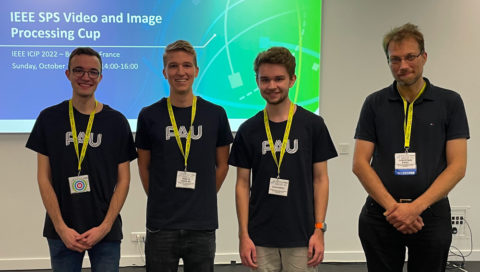FAU wins Video and Image Processing Cup 2022 on Synthetic Media Detection
Thriller in Bordeaux: In a dramatic finale, FAU’s undergraduate team won the first place in the 2022 Video and Image Processing Cup by the IEEE Signal Processing Society. Luca Beetz, Vinzenz Dewor, ChangGeng Drewes, and Tobias Gessler competed in the challenge to detect synthetically generated images. During August and early September, undergraduate teams from around the world submitted their machine learning solutions to the challenge. The three highest ranked teams were invited to the onsite contest at the IEEE International Conference in Image Processing (ICIP) in Bordeaux. FAU’s team qualified for the onsite contest by securing the third place. For the onsite contest, they were asked to submit another solution for a new test set. In Bordeaux, it turned out that this solution promoted FAU’s team to second rank. Finally, FAU’s student excelled in the team presentation, the method Q&A, and in their team description paper, which lead to a photo finish first place. Congratulations to the winners!
Their supervisors Anatol Maier and Christian Riess are proud of this achievement. “Our students did a great job! In the finale, they surpassed all expectations” said Christian Riess who was also onsite in Bordeaux. The first place is awarded with $5000 for the students. In addition to that, as finalists they had the opportunity to visit the scientific conference and the associated industry exhibitions and contact fairs. “It was a super interesting experience to be at the conference” concluded Tobias Gessler the impressions of their six-day visit in Bordeaux.
The IEEE Image and Video Processing Cup is an annual challenge that is organized by IEEE’s Signal Processing Society (SPS). The task of one year are organized by one of the SPS technical committees. In this year, the challenge was organized by the Technical Committee on Information Forensics and Security. Participants were given the task to distinguish whether images are real or synthetically generated. This task became increasing attention in past years both in scientific context and in popular media due to the emergence of the infamous “Deep Fakes”, which loosely subsumes synthetically generated faces or computer-modified faces in images or videos.
